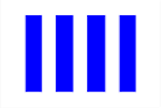Dictionary of Vexillology: F (FNFL Jack – Fourth Canton) (original) (raw)
FNFL JACK
See ‘jack of honour’.

Jack of the FNFL (Forces Navales Françaises Libres), France
FOLK FLAG
A homemade national or sub-national flag of simplified design (see also ‘unofficial flag’).
FOLKLORE (or FOLK) ORNAMENT
A decorative band usually (but not invariably) placed along the hoist of a flag, and intended to represent an element of cultural identity – a folk ornament – but see ‘national ornament’.

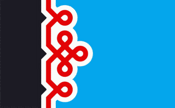
Flag of Batken, Kyrgyzstan; Flag of the Mulgi people, Estonia
Notes a) These are not established terms, but have been introduced by the Editors since no established alternatives could be found. b) The terms “National Ornament” and “Folklore Ornament” are often synonymous since the former was often adopted from the latter.
FOOTBALL FLAG
See ‘sports flag’.

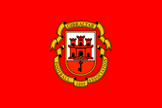

Flag of Manchester United FC, UK; Flag of the Gibraltar Football Association; Flag of Lincoln City FC, UK
FORCENÉ
The heraldic term used when a horse is seen rearing on its hind legs – but see also ‘rampant’ and ‘salient’.
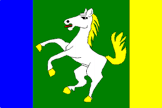
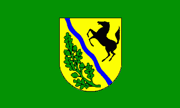

Flag of Lačnov, Czechia; Flag of Leegebruch, Germany; Flag of Badendorf, Germany
FORE, AT THE
(adv) The phrase used when a flag is flown at the truck on the foremast of a ship it is described as being – at the fore’ – see ‘foremast’ (also ‘mast’, ‘masthead’ and ‘truck’).
[ ![[at the fore example]](http://www.crwflags.com/fotw/images/v/vxt-d3594.gif) ](../images/v/vxt-d3594.gif)
](../images/v/vxt-d3594.gif)
Flag of a Vice-Admiral 1864–1898, UK
Please note that in the sailing/steam-assisted navy, the command flag of a vice-admiral was formerly flown in this position (also ‘balls of difference’, ‘flag of command’ and ‘flagship’).
FORE DOWN
The forward line upon which signal flags are displayed when a vessel is dressed overall – see ‘dressing lines’, ‘dress ship 1)’ and ‘dress ship 4)’.
FOREMAST (or FORE)
The forward vertical mast in a three or four masted sailing ship or the forward mast of a motor vessel regardless of the number of masts – see ‘fore, at the’, (also ‘mainmast’, ‘mast’ and ‘mizzen’).
FORKED CROSS
The term that may be used for a particularly Germanic form of the cross fourché – a cross formed by four trammel-hooks – a ‘Kirchenspange’ – but see ‘cross fourché’ (also ‘andiron’ and ‘cross 2)’).

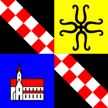
Flag of Affoltern district, Switzerland, Flag of Kappel am Albis, Switzerland
Please note that this term has been introduced by the Editors to avoid any possible confusion with the existing term “hooked cross” – see ‘hooked cross’.
FORKED ENSIGN
See ‘swallowtail(ed)’.
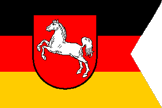
State Ensign of Lower Saxony, Germany
FORKED MERLONS
In heraldry see embattled fourché.

Flag of Carabietta, Switzerland
FORK(ED)-TAIL (or FORK-TAILED)
See ‘swallow-tail(ed)’.
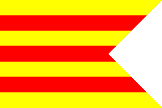
Flag of Galanta, Slovakia
FORMÉE (FORMÉ or FORMY) CROSS
In heraldry see ‘cross pattée’.

Flag of Vilamacolum, Spain
FORTRESS FLAG
The term for a flag, now obsolete, that was flown over military defences (either inland or coastal). In British and Russian usage this was the naval jack, whilst in others the war flag/naval ensign or the state/national flag (or a variant thereof) might be employed.

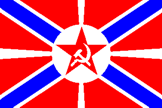

1801 Pattern of Union Jack, UK (Graham Bartram); Jack/Fortress Flag, Soviet Union 1924–1932; State Flag/Naval Ensign of Norway
Notes a) Some countries use/used ensigns of special design to denote ships belonging to naval fortresses (notably Soviet Union). b) It is also not unknown for a country to have had sets of rank flags to denote presence of officers of particular rank/position in coastal artillery and fortresses.
FOULED ANCHOR (or FOUL ANCHOR)
In United Kingdom usage and some others, the terms for an anchor entangled with its cable – but see ‘cabled’ (also ‘admiralty flag’, ‘anchor’ and ‘anchor flag’).

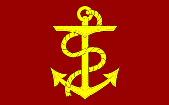

Flag of the Naval Board, Canada; Flag of the Admiralty Board, UK; Flag of the Chief of the Navy Board, Australia
Please note that in UK usage the fouled (or foul) anchor is considered a symbol of the Royal Navy, and that officers of the British merchant marine show an anchor (of a slightly differing pattern) without its cable on their cap badges and buttons.
FOUNTAIN (or FOUNT)
- In traditional heraldry a roundel bearing a number of wavy lines on an argent field which represents an architectural feature – a roundel barry wavy (see also ‘argent’, ‘azure’, ‘barry’, ‘roundel 3)’ and ‘wavy’).
- In in modern heraldry and in vexillology the (sometimes stylized) pictorial representation of a decorative/architectural device which pours or projects water – a water-pouring, water-gushing or waterspout fountain.
[ ![[fountain example]](http://www.crwflags.com/fotw/images/v/vxt-d4758.gif) ](../images/v/vxt-d4758.gif) [
](../images/v/vxt-d4758.gif) [ ![[fountain example]](http://www.crwflags.com/fotw/images/v/vxt-d5457.gif) ](../images/v/vxt-d5457.gif) [
](../images/v/vxt-d5457.gif) [ ![[fountain example]](http://www.crwflags.com/fotw/images/v/vxt-d5337.gif) ](../images/v/vxt-d5337.gif)
](../images/v/vxt-d5337.gif)
Flag of Carragosa, Portugal; Flag of Funtana, Croatia; Flag of Eirado, Portugal
FOUNTAIN FILL
See ‘gradient fill’.
[ ![[Gradient fill example]](http://www.crwflags.com/fotw/images/v/vxt-d1171.gif) ](../images/v/vxt-d1171.gif)
](../images/v/vxt-d1171.gif)
Flag of the Christlich-Soziale Union, Bavaria, Germany
FOUR COLOUR PRINTING SYSTEM
See ‘CMYK’.
FOUR FREEDOMS FLAG
See ‘honour flag 1)’.
FOURCHÉ (or FOURCHÉE)
The Old French for forked – in heraldry see cross fourché, embattled fourché and queue fourché.



Flag of Faido, Switzerland; Flag of Castel San Pietro, Switzerland; Flag of Martigny, Switzerland
FOURRAGÈRE
See ‘lanyard 1)’ (also ‘lanyard pennant’).
[ ![[fourragère]](http://www.crwflags.com/fotw/images/v/vxt-d1419.jpg) ](../images/v/vxt-d1419.jpg)
](../images/v/vxt-d1419.jpg)
(marlow white)
FOURTH CANTON (or QUARTER)
Alternative terms for that quarter of a flag which occupies the lower fly – the fourth quarter, lower fly or lower fly canton – see canton 3) (also hoist 1)).
[ ![[fourth canton]](http://www.crwflags.com/fotw/images/v/vxt-d1576d.gif) ](../images/v/vxt-d1576d.gif)
](../images/v/vxt-d1576d.gif)
